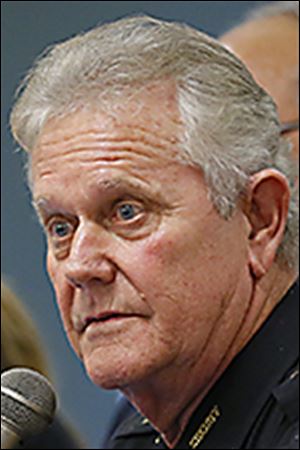
EDITORIAL
Getting schooled on addiction
9/1/2014
Tharp
Treatment, law enforcement, and prevention are all important as Ohio battles an opioid and heroin epidemic. On balance, however, stopping people from becoming addicted is the most effective of the three strategies; it helps ensure that the crisis won’t continue for generations.
That’s why it’s perfectly proper, and prudent, for Lucas County’s chief law enforcement officer to push drug education and prevention in local public schools. Sheriff John Tharp told The Blade’s editorial page that he’s calling on local districts to include age-appropriate education on prescription opioid and heroin addiction in their health curricula.
The Blade’s “Prescription: Addiction” editorial series has shown the need for broader efforts, Mr. Tharp said: “This problem is too big for law enforcement alone. These are our kids and this is our community. We need to start talking about this issue early.”
Mr. Tharp, who just created an addiction resource unit in the sheriff’s office, was particularly moved by the fatal overdose last month of a 17-year-old boy from Sylvania Township. “At 17, that kid never had a chance to live and develop his talents and abilities,” he said. “It’s terrible.”
Mr. Tharp plans to call a meeting early this month with local school superintendents and leaders throughout the county to discuss expanding their health curricula. He said he already had commitments from several school districts to include information about opioid addiction, including heroin, in health classes.
Ohio’s chief law enforcement officer, Attorney General Mike DeWine, supports Mr. Tharp’s initiative. He told The Blade’s editorial page that Ohio schools sorely lack age-appropriate, comprehensive education on addiction.
“Education and prevention are two of the most important things in the fight against prescription drugs and heroin abuse,” he said. “The communities winning this fight are the communities that get everyone involved.”
A bill passed overwhelmingly by the state House this year would require schools to include prescription opioid abuse in health curricula. The Senate has not approved the bill, but that doesn’t preclude local school districts from acting on their own.
Districts here should work with the state Department of Mental Health and Addiction Services and the Governor’s Cabinet Opiate Action Team, which have already done commendable education work aimed at young people, including the “Start Talking!” program.
“Schools don’t have to re-invent the wheel,” said Andrea Boxill, the deputy director of the Governor’s Cabinet Opiate Action Team. “There are plenty of resources out there across the state.”
In recent months, Lucas County has become a state leader in dealing with Ohio’s opioid and heroin epidemic, but much more needs to be done. In northwest Ohio, heroin-related deaths are on pace nearly to double again this year.
Filling an educational void is a good place to start. Despite considerable progress in changing attitudes, many students continue to believe that highly addictive prescription painkillers such as Vicodin, Percocet, and OxyContin are safe for recreational use.
In 2014, changing such dangerous misconceptions — and preventing tragedies such as a 17-year-old’s fatal overdose — should be part of the mission of school health curricula in Lucas County and the rest of Ohio.